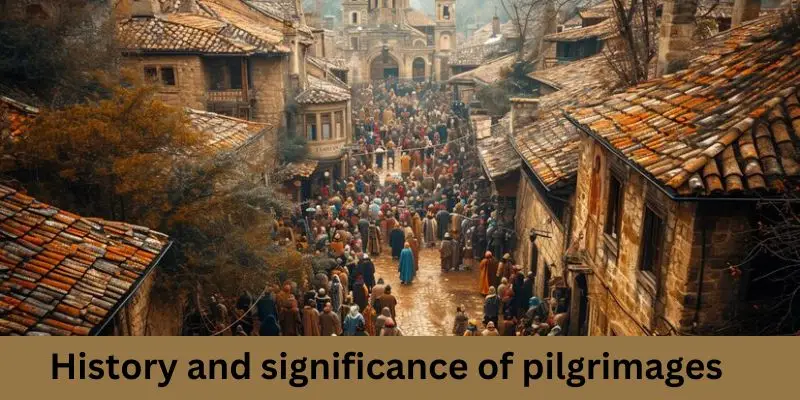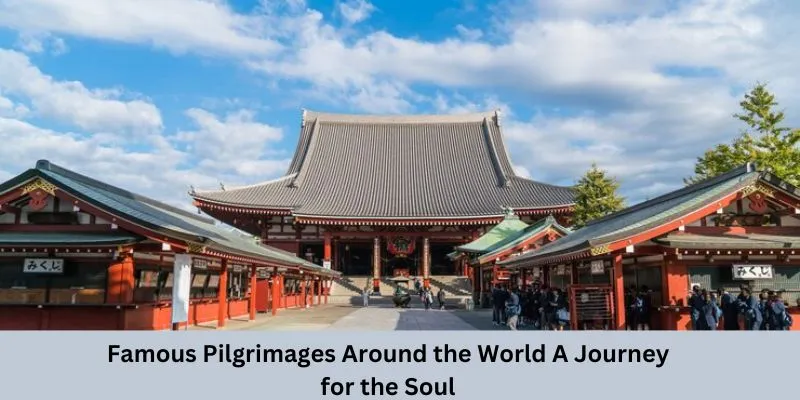A Journey Through the Lives of Famous Pilgrims
Updated: June 13, 2024
31
Have you ever caught a breathtaking peak-peak and felt a force towards its meeting? Or has a religious site worldwide gossiped its name in your goals? The heart of the pilgrim’s way is a call to challenge yourself and desire something more profound. People from all walks of life and religions have brought pilgrimages for centuries. These travels exceed mere physical travel.
They are about personal change, self-discovery, and a powerful link to something larger than oneself. Whether it is the dusty paths directing to Mecca, the iconic Camino de Santiago in Spain, or the mystical gradients of Mount Kailash in Tibet, pilgrimages have carved a unique way through human history.
Definition of a pilgrim
A pilgrim carries a long journey, often to a place thought holy or special by their faith. Think of it as a spiritual experience. These journeys can be physically taxing, but pilgrims believe the goal is worth the effort. They might visit a shrine, a holy city, or a place related to their faith’s history. For the pilgrim, the journey can be a meaningful part of the experience.
History and significance of pilgrimages
For centuries, people of all beliefs have embarked on pilgrimages, tackling journeys with a deeper meaning than just sightseeing. These bodily and spiritual journeys hold massive significance in many beliefs, shaping civilizations and practices worldwide.

The Call of the Holy Place
The view of crossing to a holy site is at the heart of a pilgrimage. It could be the motherland of a religious figure, a shrine associated with benefits, or a location considered to hold great spiritual power. These goals are unique for believers, presenting a chance to join with the religious, seek gifts, or express thanks.
A History Steeped in Tradition
The practice of pilgrimage extends far back in time. Obsolete Greeks journeyed to Olympia for the Olympic Games, a travel that swirled religious and firm value. Hinduism has several pilgrimage sites, with Varanasi as one of the most sacred—the Abrahamic faiths of Judaism, Christianity, and Islam. Set pilgrimage routes, with Jerusalem, Mecca, and the Holy Land having colossal significance.
Pilgrimage in the Modern World
The tradition of pilgrimage restarts to thrive today. Modern-day pilgrims journey by planes, trains, and even cars, yet the core goal stays the same – a spiritual journey towards a holy place. Whether for religious reasons, self-discovery, or a unique travel adventure, pilgrimages offer a prospect to join with something bigger than ourselves.
Types of pilgrimages and destinations
Pilgrimages are journeys with a more profound goal. They seek something above daily life, a case for personal change and spiritual growth. These trips can take many shapes, but they all share a typical thread: a destination with deep significance to the pilgrim’s beliefs or feelings.
Christianity: The Holy Land (Jerusalem, Bethlehem), Rome (Vatican City), Santiago de Compostela (Spain)
Islam: Mecca (Hajj pilgrimage)
Hinduism: Kumbh Mela (various locations), Varanasi (India)
Buddhism: Bodh Gaya (India), Lumbini (Nepal)
Judaism: Jerusalem (Western Wall)
The Pilgrim’s Journey A Path of Challenge and Reward
The call to pilgrimage is strong, beckoning people of faith to essay on a religious journey. This knowledge is more than just a trip. It is a transformative method loaded with practice and challenges, finally showing profound tips.
A. Embracing the Journey Preparation and Planning
Before placing foot on the pilgrim’s path, careful planning is vital. Typical rituals or practices need to be learned when knowing about the pilgrimage. Physically, bringing in good shape is essential, as many travels affect long journeys and challenging exercises. Packing provisions, providing proper travel papers, and arranging logistics are crucial to a smooth and successful pilgrimage.
B. Facing the Unknown Physical and Spiritual Challenges
The pilgrim’s path is challenging. Physical challenges, like long spaces, extreme weather, and foreign backgrounds, can test one’s constancy. These problems, however, can also be development options. The spiritual journey can be equally demanding. Pilgrims often face self-doubt, scuffle with internal efforts, and may even participate in moments of pain. These challenges can lead to deeper thinking, a stronger relationship with the divine, and a continued feeling of purpose.
C. The Pilgrim’s Reward Blessings and Transformation
Despite the problems, pilgrimage has big rewards. Pilgrims often report a deep sense of peace, a restored faith, and a deeper relationship with their spiritual society. The shared experience of crushing challenges with fellow pilgrims promotes a powerful glue.
Famous Pilgrimages Around the World A Journey for the Soul
Across the world, people essay on great journeys not for sightseeing but for something more deep – a pilgrimage. These travels hold considerable spiritual significance, letting pilgrims touch with their faith, remember, and seek inner calm.
A. The Camino de Santiago (Spain)
This network of courses, also known as the Path of St. James, threads via stunning terrains in Spain, leading to the decent burial site of St. James, one of Jesus’ ministers. Pilgrims walk for weeks, enjoying artistic immersion and study.

B. Hajj to Mecca (Saudi Arabia)
For Muslims, the Hajj is a required pilgrimage to Mecca, the holiest city in Islam. Millions gather yearly to perform habits around the Kaaba, a cubical structure thought to have been built by Abraham and Ishmael. It is a powerful display of harmony and devotion.
C. Varanasi (India)
The holy city of Varanasi, along the Ganges River, is a Hindu pilgrimage site. Pilgrims consider washing in the Ganges to wash away evils and help them reach moksha (liberation). The city pulses with life and spirituality, delivering a unique adventure.
D. Lourdes (France)
The small village of Lourdes in France evolved into a pilgrimage site after a young girl named Bernadette Soubirous reported shades of the Virgin Mary. Millions of Catholic pilgrims visit the cave where the ghosts occurred, seeking recovery and spiritual revival.
The Pilgrimage of Grace (England)
It was not a typical pilgrimage but a rebellion in 1536 against King Henry VIII’s spiritual reforms. People across England opposed the break from the Catholic Church, undertaking an extended pilgrimage to support their faith.
The Journey of the Benefits Pilgrimage
For centuries, people from all walks of life have embarked on pilgrimages. These journeys are more than simply sightseeing trips. They are deeply emotional searches for spiritual development, self-discovery, and contact. But what exactly causes travel to be so transformative?
- Deepen Your Faith
Pilgrimages usually lead to religious sites, allowing pilgrims to deeply connect with their faith. Whether standing at the home of a spiritual figure or hiking in their footsteps, these occasions can support beliefs and bring clarity to spiritual questions.
- Inner Reflection and Growth
An inner one often reflects the physical journey of a pilgrimage. Drawn from the daily struggle, pilgrims have time for reflection and self-discovery. The isolation and strange surroundings can flash powerful, unique insights and a continued sense of meaning.
- Community and Belonging
Many pilgrimages affect touring with others who share identical views. This shared understanding fosters a strong sense of neighbourhood and belonging. Pilgrims help and learn from each other, making lasting cement that better geographical and artistic borders.
- A Break from the Ordinary
Our everyday lives can become tiresome. A pilgrimage breaks this way, letting us step outside our convenience zones and welcome new adventures. It can be a powerful reset button, allowing us to return home with a fresh outlook and gratitude for life’s easy joys.
- Physical and Mental Wellbeing
Many pilgrimages involve walking or walking through stunning terrain. Engaging in nature is a well-known anxiety reliever that can elevate one’s spirit. The physical challenge of a pilgrimage can even improve one’s strength and self-confidence.
- Connection to History and Culture
Pilgrimage goals are often soaked in history and cultural importance. By seeing these places, pilgrims gain a more profound sense of their heritage and the practices of others. It promotes patience and care for diverse views and courses.
Conclusion
Our pilgrimage experience comes to a close. We have studied the history, causes, and incidents of pilgrims. You may have sensed a spark of motivation and desire to tackle your pilgrimage. Pilgrimage is around more than just getting a clear destination. It is about the internal journey, the change that happens within you as you walk, study, and reflect. It is about pursuing something greater than yourself, whether religion, learning, self-discovery or a plunging relationship with the world about you. The path of a pilgrim could be softer. There will be challenges, distrust, and points where you want to give up. But the bonuses – the feeling of achievement, the newfound attitudes, the peace within – are worth every effort.
Please Write Your Comments